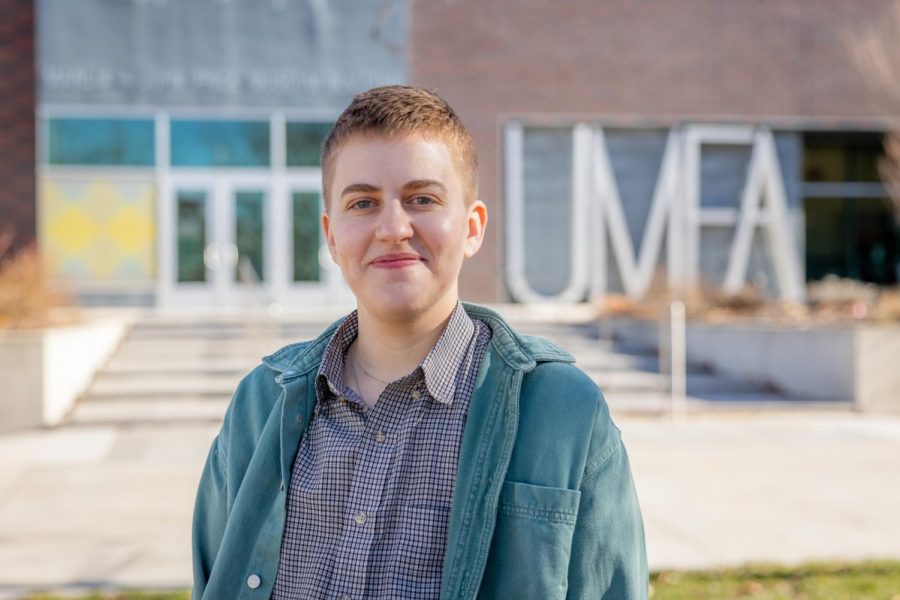Gardner: The Chronicle Showed Me the Power of Art
Chrony Assistant Arts Editor, Paige Gardner, poses in front of the UMFA in Salt Lake City on Wednesday, March 23, 2022. They chose the UMFA as the location for their portraits and had many classes there during their time at the U. (Photo by Jack Gambassi | The Daily Utah Chronicle)
April 27, 2022
“Why art?” is a question I get asked a lot, and it’s one that I ask myself often. I honestly didn’t really have an answer for it when I transferred to the University of Utah in the fall of 2020. However, at the end of my time here at school, I finally feel like I know the answer to this question, even if I don’t know exactly what I’m going to do with it.
Journey to Journalism
I joined the arts desk at the end of my first semester not as a journalist, but as an artist. I hadn’t decided I wanted to be an artist yet. I was merely someone who had always enjoyed making art and engaging with it. I’d seen my friends Josh Petersen and Jacqueline Mumford write for the arts desk and what can I say? They were cool and smart; I wanted to be like them!
I started writing on the arts desk before I’d even chosen to major in art history and while I still thought I was going to be an attorney (lol). I’d never been involved in anything on campus. I was never one to make friends in class or go to events on campus and I was just trying to get through the whole thing as quickly as possible.
Being the assistant editor under Hannah Keating was the perfect factor in changing that equation. They have kept me laughing the last couple years and have made this whole thing exceptionally enjoyable through all of the frantic ups and downs of juggling our responsibilities, though I can’t claim to be juggling even marginally as much as Hannah.
She has been our fearless, ever-occupied, theater-loving leader and I will miss working with her the most. Our writers are much smarter than us and we are leaving the arts desk in their very capable hands; theirs will be a journey you will certainly want to follow.
My time at the Chronicle made me reconsider my method of brute-forcing my way through school and forced me to slow down and pay attention to the community that I was a part of. I joined for something fun to do and I’m leaving more assured of my place in the world and convinced of the importance of arts and journalism.
Choosing Art
It’s easy to feel insecure about the importance of the arts, two disheartening years into the pandemic and 200,000 or so years into a very fraught human history, but it’s actually in consideration of that context I find I’m able to understand the value of prioritizing art.
Studying art history has, to my surprise, helped me answer a lot of the philosophical questions I was grappling with as I approached the final years of my undergraduate study. As I’m sure many in Utah can relate, the years after a shift away from the religious paradigm you grew up with are not easy to navigate existentially. I felt like I was back at square one looking for answers and I found them in art.
In my classes, we’ve looked at art in its earliest stages thousands and thousands of years ago side-by-side with contemporary art that truthfully isn’t all too different. Each art object and artifact I looked at and every musing on art history theory I read gave me a glimpse into human nature, politics, science and culture.
The tradition most of us were brought up in — the violent, white, settler-colonial one — presents us with a very limited view of the role of the arts. Art that shakes things up is not quite as important as art that can be an investment. Often those two distinctions overlap. Anything outside of that is just a pastime, something to do in the few hours of free time you have on the weekend if you’re not already completely exhausted.
I would argue that even the smallest acts of art have the power to subvert that entire notion. Art can be something that propels a movement, something you build a career out of or something that reminds you that you are not just — to use a very technical anthropological term — a capitalist money robot.
Interviewing artists for stories I was working on showed me the very real power art has to build community and change the tired systems we adhere to. Artists have always been and will continue to be vital components in dismantling social injustice and in making the world more habitable and interesting.
I hope in my time at the Chronicle I have in some part convinced our readers of that.









